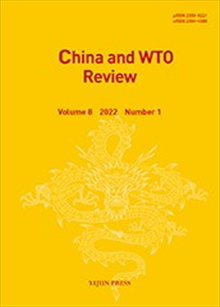간행물
China and WTO Review KCI 등재 SCOPUS

- 발행기관 이준국제법연구원
- 자료유형 학술지
- 간기 반년간
- ISSN 2383-8221 (Print)2384-4388 (Online)
- 수록기간 2015 ~ 2023
- 주제분류 사회과학 > 법학 사회과학 분류의 다른 간행물
- 십진분류KDC 341DDC 321
권호리스트/논문검색
Volume 4 Number 1 (2018년 2월) 11건
1.
2018.02
구독 인증기관 무료, 개인회원 유료
This article assesses the compliance of China’s domestic laws in the area of intellectual property rights protection with the WTO Agreement on Trade-Related Intellectual Property Rights (TRIPS), which China obliged to accept upon its entrance into the WTO. It also discusses the implications which result from the implementation and enforcement of the intellectual property rights in China for doing business in China. The significance of intellectual property rights protection for achieving the strategic objects formulated by China’s policy-makers and China’s reputation in the world is tackled, as well. Qualitative research based on the concept of compliance showed that China’s compliance with its TRIPS obligation should be evaluated with respect to different country-specific as well as country non-specific factors. However, the experience from the historical development of the leading world inventors, such as Japan or the United Kingdom, should also be considered.
6,700원
2.
2018.02
구독 인증기관 무료, 개인회원 유료
It is not easy to detect East Asia’s presence in the field of investor-state dispute settlement (ISDS), despite its large economy. In addition to having less active foreign direct investment (FDI) relative to GDP and fewer investment treaties, East Asian economies and societies seem to possess certain characteristics that have contributed collectively to the dearth of ISDS cases in East Asia. Examples are the short history of international arbitration, the avoidance of litigation, the high proportion of state-owned enterprises in outward FDI from China, and the concentration of FDI in industries in which investor-state disputes are less likely to occur. This trend, however, is likely to change gradually with the ongoing socioeconomic changes in the region, including the increase in both outward and inward FDI, the increasing number of investment treaties, the growing familiarity with international (investment) arbitration among legal experts, the diversification of FDI, and the decreasing fear of administrative litigation.
7,700원
3.
2018.02
구독 인증기관 무료, 개인회원 유료
In recent years, China initiated Big Data strategies and put forward a series of legislative proposals with regard to the regulation and utilization of Big Data technology. However, academics have not reached consensus to fundamental questions such as data ownership and protection approaches yet. The intrinsic contradiction lies in the difference of values between Big Data which emphasizes “open and sharing” and intellectual property law that protects monopoly interests. This article seeks to conceptualize Big Data in a dynamic approach with an aim to frame the dialogue for further discussion. Through analyzing whether current intellectual property laws in China serve a solid base for promoting the development of big data technology, it proposes that, in order to address regulatory impracticality of Big Data, certain statutory amendments are necessary. However, regarding the revolutionized proposition of creating a “database right” or alleging “Big Data as an object of intellectual property law,” this research recommends a modest and restrained approach.
6,400원
4.
2018.02
구독 인증기관 무료, 개인회원 유료
Professor Petersmann has developed a constitutionalization theory for IEL based on Western constitutionalism theory in conjunction with human rights law. However, there is a paradox in his theory considering that he stresses ‘legal pluralism’ on the one hand, while calling for a cosmopolitan conception of IEL on the other hand. The hypothesis of this paper is that there are no ‘universalizable’ principles and common constitutional principles that can guarantee the compatibility between the two. Petersmann’s three often-used keywords, ‘human rights,’ “principles of justice,” and “judicial protection of individual rights,” are clarified in the context of Chinese thought and China’s progressive integration into the world economy. This paper finds that Petersmann’s theory focuses on bottom-up individual struggles, whereas Chinese thought is characterized by top-down overall consideration. The value divergence between the goodness of human nature in Chinese thought and the evil of human nature in Western thought makes ‘legal pluralism’ an insurmountable obstacle to a cosmopolitan conception of IEL.
6,000원
5.
2018.02
구독 인증기관 무료, 개인회원 유료
This paper reviews presents the advantages and disadvantages of mediation in Chinese commercial arbitration process to resolve disputes. Mediation can be considered as a principal means for resolution of commercial disputes, both domestically and internationally. Simply, to mediate means to act as a peacemaker between dispute parties. Basically, mediation is an informal mechanism in which the disputants are assisted by a neutral third party toward settlement. The mediators are appointed in a voluntary base to help disputants manage the resolution process. They should have no direct interest in the conflict and its outcome, and no power to render a decision, but just can control the process. Meanwhile, parties are entitled to accept or reject the outcome. Mediation shares the advantages of confidentiality, flexibility, and simplicity. Dispute of disadvantages still remaining, China’s mediation system has century’s history so far. Currently, China has used mediation method in arbitral proceedings so as to improve the efficiency of dispute resolution.
4,900원
6.
2018.02
구독 인증기관 무료, 개인회원 유료
4,200원
7.
2018.02
구독 인증기관 무료, 개인회원 유료
4,200원
8.
2018.02
구독 인증기관 무료, 개인회원 유료
4,000원
9.
2018.02
구독 인증기관 무료, 개인회원 유료
4,000원
10.
2018.02
구독 인증기관 무료, 개인회원 유료
4,000원
11.
2018.02
구독 인증기관 무료, 개인회원 유료
3,000원

